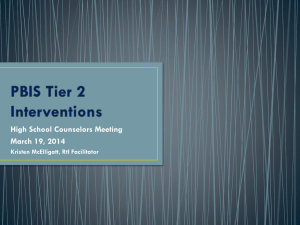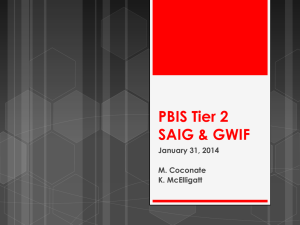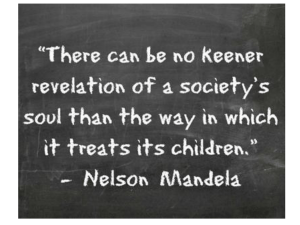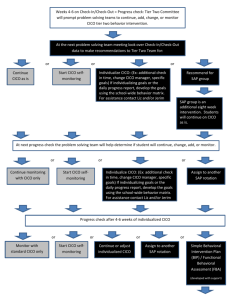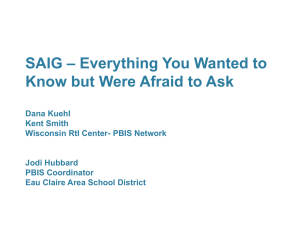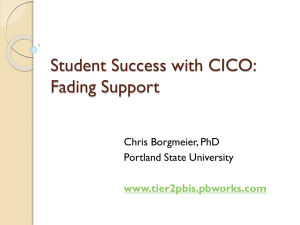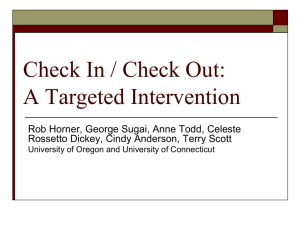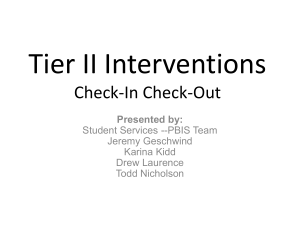PBIS Tier 2 Critical Features
advertisement
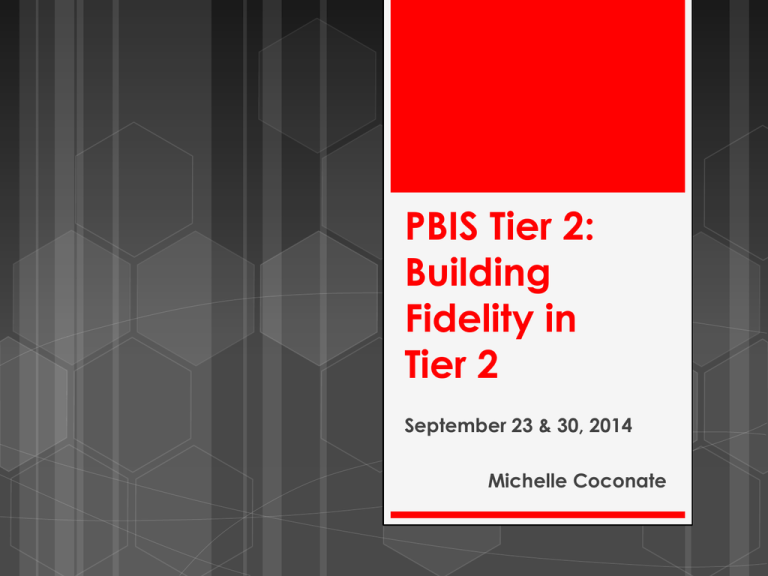
PBIS Tier 2: Building Fidelity in Tier 2 September 23 & 30, 2014 Michelle Coconate Behavioral Expectations EXPECTATION BE RESPECTFUL TRAINING SITE Turn cell phones “off” or to “vibrate” Listen to each other & share ideas Make yourself comfortable & take care of your needs Ask questions BE Use time wisely RESPONSIBLE Network with other school teams Leave no trace BE PREPARED Use your data Record tasks on MAP Follow up on tasks after today! TODAY’S GOALS REVIEW CICO, SAIG, AND GWIF BEGIN EXPANDING THE CICO HANDBOOKS INTO A TIER 2 HANDBOOK UNDERSTAND TIER 2 CREATE THE DATA PIECES INVOLVED IN AN ACTION PLAN Agenda Business… Announcements PD Calendar & Assessment Tools Focus Document Guiding Questions & Critical Features CICO/SAIG/GWIF Review Data-Based Decision Making Team Meetings Planning Time Lunch will be from 11:30-12:30…on your own Guiding Questions BIG ONE…Are your Tier 2 Interventions being implemented with fidelity??? Are your PBIS Tier 2 interventions aligned to the critical features? How do you know? Are your PBIS systems culturally responsive? How do you know? Are your PBIS Tier 2 group interventions effective? How do you know? How are you documenting the integrity/fidelity of the interventions? What data needs to be shared with all staff? How often? Why? 10 Critical Features of Tier 2 Interventions 1. Intervention linked directly to school wide expectations and/or academic goals. 2. Intervention continuously available for student participation. 3. Intervention is implemented within 3 school days of determining the student is in need of the intervention 4. Intervention can be modified based on assessment and/or outcome data Critical Features continued 5. Intervention includes structured prompts for what to do in relevant situations. 6. Intervention results in students receiving positive and/or corrective feedback from staff. 7. Intervention includes a school-home communication exchange system at least weekly. Critical Features continued 8. Orientation process and introduction to materials is provided for students as they begin the intervention 9. Orientation to and materials provided for staff/sub’s/volunteers who have students using the intervention. Ongoing information shared with staff. 10. Opportunities to practice new skills are provided daily. Outcomes Academic & behavior targets that are endorsed and emphasized by students, families, and educators Practices Curricula, instruction, interventions, and strategies that are evidence-based Data Information that is used to identify status, need for change, and effects of interventions Systems Supports that are needed to enable the accurate and durable implementation of the practices of PBIS CICO SAIG GWIF Check-In/ Check-Out Social/ Academic Instructional Groups Groups with Individualized Features Checkpoint/Sharing Where are you with implementation of CICO, SAIG, & GWIF groups? What is working? What issues have you resolved? What questions do you have? Resources VIDEO: The Behavior Education Program: a CheckIn/Check-Out Intervention for Students at Risk Resources Book: Responding to Problem Behavior in Schools: The Behavior Education Program (Crone, Horner, & Hawken, 2010) Leanne Hawken Materials https://www.dropbox.com/sh/qwpddz9y vioiab4/KQKPPMQtGm Resources Webinars, etc… http://www.pbisillinois.org/trainings/ webinar-training-recordings www.pbis.org Roles & Responsibilities Coordinator(s) Facilitators Organizes and/or oversees the specific interventions such as CICO, SAIG & GWIF Directly provides intervention support services Roles include: schedule meetings; review & collect individual student data to share during PBIS Tier 2 meetings, etc. Roles include: meeting with students for CICO, running groups Note: Tier 2 team checks for fidelity & intervention effectiveness. Sending out Reverse Requests for Assistance Communicating with Coordinator about issues/questions Check-In/Check-Out Reminders First level of Tier 2 intervention Extension of Tier 1 Same for all identified students Large group intervention Support for 7-12% of the school population High frequency positive or neutral feedback Low impact on staff time CICO Cycle Students are identified based on data rules or request for assistance. Every 2 weeks Coordinator reviews individual student DPR data Morning Check-In @ 4 weeks Coordinator determines level of success Responding = Continue Home Check-In DPR & Other Data Afternoon CheckOut Daily Teacher Evaluation Not Responding = Reverse Request for Assistance Monthly Systems Team Meeting Coordinator reports data Team completes tracking tool Team makes data-based decisions Adapted from Crone, Horner, Hawkin (2004) Daily Progress Report (DPR) Sample NAME:______________________ DATE:__________________ Teachers please indicate YES (2), SO-SO (1), or NO (0) regarding the student’s achievement in relation to the following sets of expectations/behaviors. 1 st block 2 nd block 3 rd block 4 th block EXPECTATIONS 2 Be Safe 1 0 2 1 0 2 1 0 2 1 0 Be Respectful 2 1 0 2 1 0 2 1 0 2 1 0 Be Responsible 2 1 0 2 1 0 2 1 0 2 1 0 Total Points Teacher Initials Adapted from Grant Middle School STAR CLUB Adapted from Responding to Problem Behavior in Schools: The Behavior Education Program by Crone, Horner, and Hawken Reverse Request for Assistance Reverse Request for Assistance: Interventions Change (Addressed to Student’s Teacher) Student Name: ________________________________________ Date: __________________ Grade: _________ IEP (circle one) Yes No Teacher: _____________________________________ Based on preliminary data, it has come to our attention that the _____________________ Intervention (CICO) is NOT having a significantly positive effect on your student (i.e. he/she “is not responding” well to the intervention). Please identify which additional support/s, you feel, would be the best fit for this youth. 1) ____No change in behavior support requested at this time, please continue CICO. 2) Social/Academic Instructional Groups: ____Problem-Solving: To learn replacement behaviors for fighting, arguing etc. (externalizing behaviors) ____Pro-social Skills: To learn replacement behaviors for avoidance, withdrawal etc. (internalizing behaviors) Academic: ____Academic Behavior: To learn replacement behaviors for calling out, getting out of seat, behaviors related to homework etc. ____Academic skills/content area 3) Individualized Check-In/Check-Out: Same CICO with one or more of the following changes: ____Change location of Check-In and/or Check-Out ____Change Check-In/Check-Out person (change adult or use a peer instead) ____Change Check-In and/or Check-Out time (or add addition time/s) 4) ____ Mentoring (Focus is on connection/relationship between one adult and youth, designed/individualized based on youth needs) Thank you! School Example Sharing… Woodrow Wilson CICO Process Woodrow Wilson Check In/Check Out Badger B.E.S.T. (Believe in yourself, Excellent effort, Show respect, Take responsibility) TEAM Planning/Discussion Based on the 10 Critical Features of Tier 2 interventions and other CICO information… Take the next 30 minutes to: Review your CICO plan and note adjustments that need to be made on your MAP Discuss your process for identifying students for CICO (IN-ON-OUT) and determine if it is in writing (such as a flow chart) Other PBIS 3 Tiered System of Support Teams Universal Team Plans SW & Class-wide supports Secondary Systems Team Uses Process data; determines overall intervention effectiveness Universal Support CICO GWIF CICO w/ Individualized Features OR 1/2014 – Adapted from PBIS Illinois Mentoring SAIG Problem Solving Team Standing team; uses FBA/BIP process for one youth at a time Tertiary Systems Team Uses Process data; determines overall intervention effectiveness Brief FBA/ BIP Complex FBA/BIP Wraparound SAIG Social Academic Instructional Groups Three types of skills-building groups: 1) Pro-social skills 2) Problem-solving skills 3) Academic behavior skills • Involves use of Daily Progress Report (DPR) Card with focus areas Daily Progress Report (DPR) Sample NAME:______________________ DATE:__________________ Teachers please indicate YES (2), SO-SO (1), or NO (0) regarding the student’s achievement to the following goals. 1 st block EXPECTATIONS 2 Be Safe Use your words Use deep breathing Be Respectful Keep arm’s distance Use #2 voice level when upset Be Responsible Ask for breaks Self-monitor with DPR 1 2 nd block 0 3 rd block 4 th block 2 1 0 2 1 0 2 1 0 2 1 0 2 1 0 2 1 0 2 1 0 2 1 0 2 1 0 2 1 0 2 1 0 Total Points Teacher Initials Adapted from Grant Middle School STAR CLUB Adapted from Responding to Problem Behavior in Schools: The Behavior Education Program by Crone, Horner, and Hawken Three Types of Skill-Building SAIG Pro-social skills Replacement behaviors for avoidance, withdrawal, etc. Friendship Skills/Social Awareness/Relationship Building Problem-solving skills Replacement behaviors for fighting, arguing, etc. Conflict Resolution Skills/Anger Management Skills/Self Management Academic Behavior Skills Replacement behaviors for getting out of seat, poor study habits, talking out during instruction, etc.) Study/Organizational Skills/Focus/Self-Management Skills/Responsible Decision-Making SAIG Selection into groups should be based on youths’ reaction to life circumstance, not existence of life circumstances (ex. fighting with peers, not family divorce) Skills taught are common across youth in same group (ex. “Use your Words” for all students in problem-solving skills group) Data should measure if skills are being used in natural settings, not in counseling sessions (Is there a transference of skills to classroom, cafeteria, etc.?) Stakeholders including students, teachers, and parents should have input into success of intervention (Daily Progress Report (DPR) Card) TEAM Planning/Discussion Based on the 10 Critical Features of Tier 2 interventions and other information… Take the next 20 minutes to: Discuss SAIG groups that are currently being implemented and note adjustments that need to be made on your MAP Discuss logistics of putting SAIG groups in place Discuss your process for identifying students for SAIG (INON-OUT) and determine if it is in writing (such as a flow chart) Other GWIF Groups with Individualized Features 2 Types 1) CICO with Individualized Features 2) Mentoring GWIF CICO with Individualized Features Adds support to general CICO Used after general CICO has been tried for predetermined amount of time (i.e. 4-6 weeks) and student has not met predetermined goal set for ALL students Teachers choose more individualized options on the Reverse Request for Assistance form GWIF CICO with Individualized Features Tier 2 team designs the options for the school and communicates them to all staff The Reverse Request for Assistance form lists the specified options from which to choose GWIF Examples of CICO with individualized features Extra check in time before/after lunch with facilitator or other staff member Peer accompanies student to check in at beginning of the day and check out at end of the day Check in with supportive adult prior to a difficult class period GWIF Mentoring School-based Mentoring 64% of students developed more positive attitudes towards school 60% improved relationships with adults 56% improved relationships with peers 55% were better able to express their feelings 64% developed higher levels of self-confidence 62% were more likely to trust their teachers Less likely than peers to repeat a grade Average number of unexcused absences dropped Source: Curtis, T., & Hansen-Schwoebel, K. (1999). Big Brothers Big Sisters School-based Mentoring: Evaluation Summary of Five Pilot Programs Philadelphia: Big Brothers Big Sisters of America. GWIF Mentoring Resources www.mentoring.org www.bbbs.org (Big Brothers, Big Sisters) School-based mentoring study http://www.ncbi.nlm.nih.gov/pubmed/12002242 meta-analysis of mentoring research http://www.ihrp.uic.edu/researcher/david-dubois- phd Research & resources from University of Illinois Chicago, David L. Dubois, Ph.D. http://whatworks.uwex.edu/Pages/1factsheet.html TEAM Planning/Discussion Based on the 10 Critical Features of Tier 2 interventions and other information… Take the next 15 minutes to: Discuss GWIFs that are currently being implemented and note adjustments that need to be made on your MAP Discuss logistics of putting GWIF in place Discuss your process for identifying students for GWIF (IN-ON-OUT) and determine if it is in writing (such as a flow chart) Other Data-based Decision Making Data-based decision-making Data is used to monitor the effectiveness of the intervention To make decisions regarding the continuum of the intervention Intervention integrity data is monitored by the PBIS Tier 2 team Data Tools 10 Critical Features Checklist Pinpoint Tier 2/3 Tracking Tool CICO Database (measuredeffects.com) Benchmarks for Advanced Tiers (BAT) Tiered Fidelity Inventory (replaces the PoI) PBIS Apps www.pbisapps.org Ask Michelle if you need school password CICO DATABASE www.psd150.org Tier 2/3 Tracking Tool Intervention Effectiveness For the remainder of today… Review your data including Tracking Tool Add tasks to MAP Begin creating a detailed Tier 2 Handbook Develop/adjust accompanying documents Request for assistance Reverse request for assistance Develop a written document summarizing your systems processes for each intervention Orientation materials Plan staff orientation/training Tier 2 Handbook Tier 2 Handbook Guidelines…Your Tier 2 Handbook should include: Team Goal Members Statement Description o of Roles Coordinator, Facilitators, Teachers, Students, Parents Description of each intervention (CICO, SAIG Groups (each one), GWIF Criteria Daily for each intervention: IN/ON/OUT Progress Report (DPR) Request for Assistance Reverse Request for Assistance Parent Informational Letter
